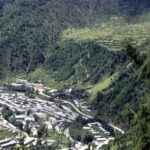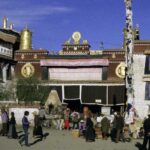Gyanste in Tibet
Gyantse is a town located in Gyantse County, Shigatse Prefecture. It was historically considered the third largest and most prominent town in the Tibet region (after Lhasa, and Shigatse), but there are now at least ten larger Tibetan cities.
Gyanste was the site of a battle between the British force, in which Francis Younghusband was Political Officer. Afterv a two month siege, the British and Indian troops men stormed the fortress as part of their 1903-1904 campaign in Tibet. The damage to the outer wall was caused by their 6lb cannon. Lt Gurdon was killed in the subsequent assault thorough the breach in the wall.
The British expedition to Tibet during 1903 and 1904 was an invasion of Tibet by British Indian forces, throught the Chumbi valley, whose mission was to establish diplomatic relations and trade between the British Raj and Tibet. In the nineteenth century, the British conquered Burma, Bhutan, and Sikkim, occupying the whole southern flank of Tibet, which remained the only Himalayan kingdom free of British influence. Additionally, the British government attempted to deal with Tibet directly prior to China’s invasion of Tibet; however, repeated efforts to establish relations and trade with Tibet failed. The motive for Britain’s expedition to Tibet stems from the orders by Lord Curzon, the head of the British India government.
The invasion was intended to counter Russia’s perceived ambitions in the East and was initiated largely by George Curzon, who had long obsessed over Russia’s advance into Central Asia and now feared a Russian invasion of British India.
In April 1903, the British received clear assurance from the Russian government that it had no interest in Tibet. “In spite, however, of the Russian assurances, Lord Curzon continued to press for the dispatch of a mission to Tibet,” a high level British political officer noted. From Kampa Dzong the expedition fought its way to Gyantse and eventually captured Lhasa, the heart of Tibet. The Dalai Lama fled to safety, first in Mongolia and later in China; but thousands of Tibetans armed with antiquated muzzle-loaders and swords were mown down by modern rifles and Maxim machine guns. The expedition forced remaining low-level Tibetan officials to sign the Great Britain and Tibet Convention (1904). The mission was recognized as a military expedition by the British Indian government, “who issued a war medal for it.”






Leave a comment